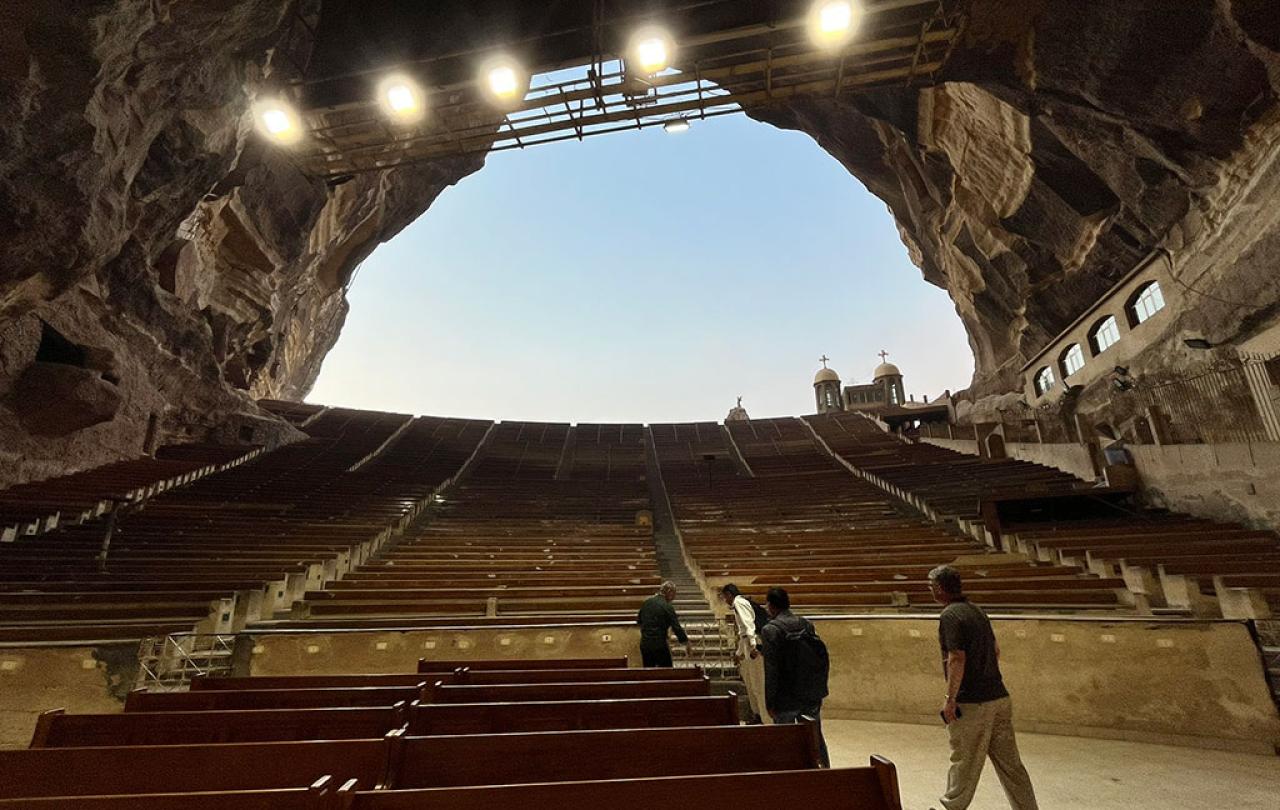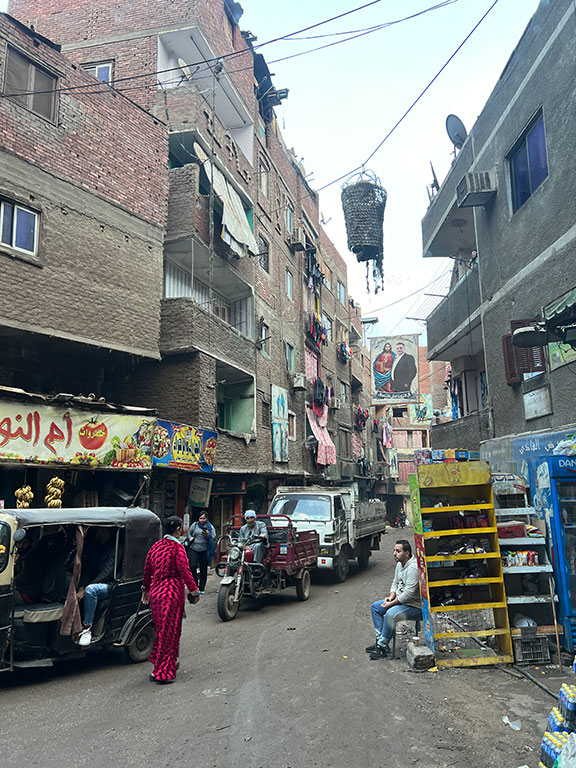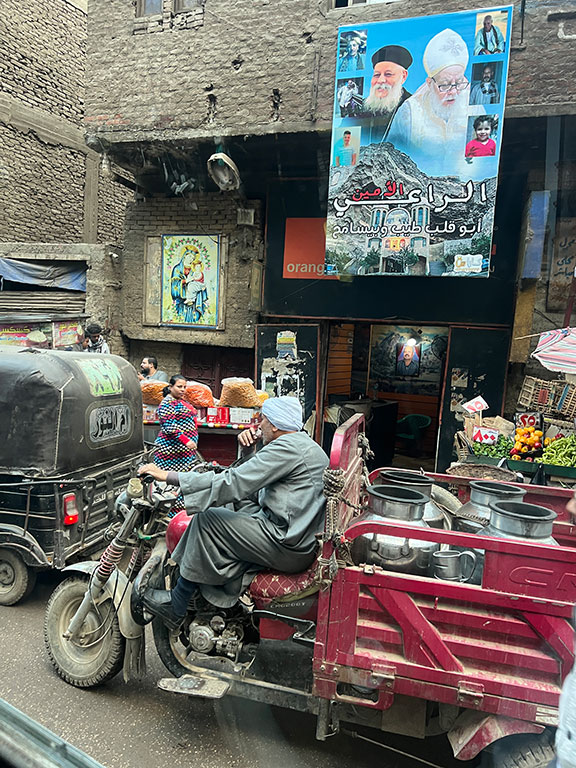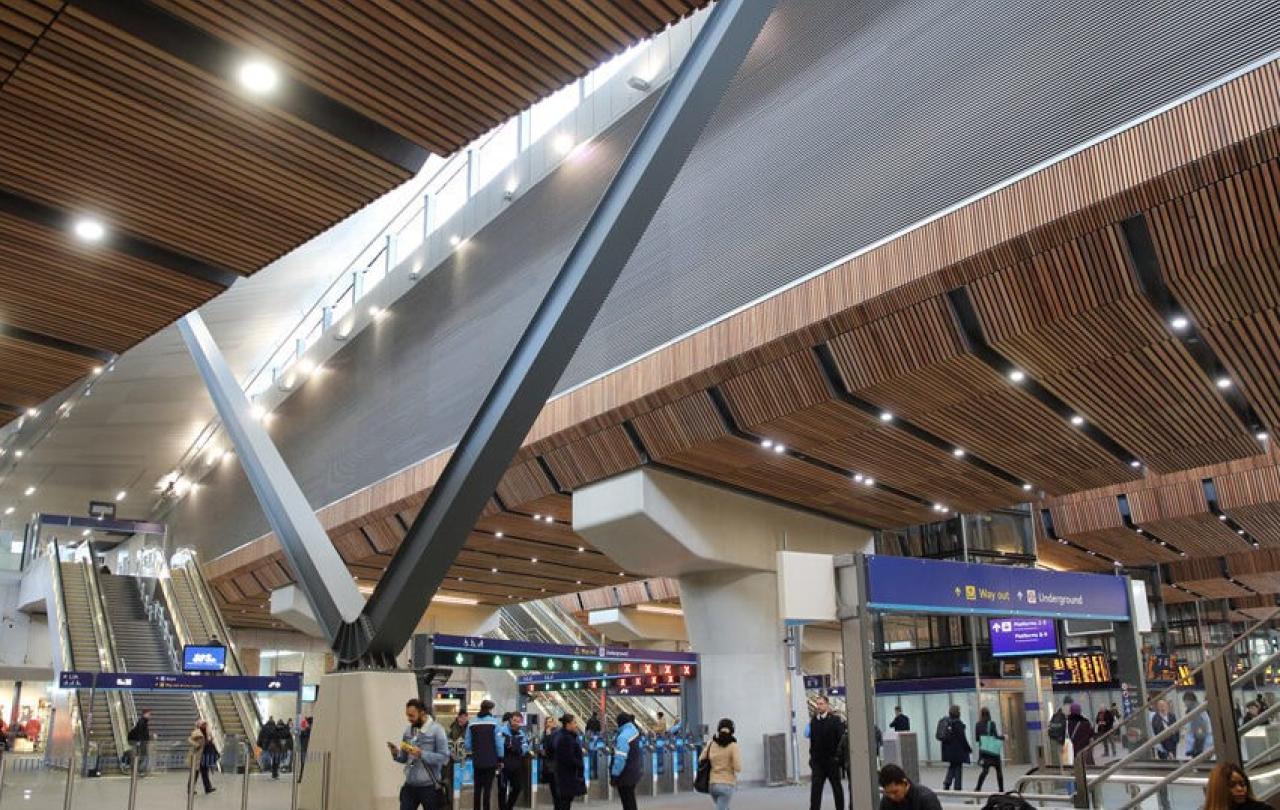
To drive through Iz-Zurrayyeb, a poor area on the outskirts of Cairo is to enter a maelstrom of noise, garbage, dust and dirt. At first glance, it looks a grim place to live. There is rubbish everywhere. Cans, plastic bottles, cardboard, wood, rags, tins. Much of the refuse of the city of Cairo – about 3000 tons every day - ends up here.
Yet the most surprising thing is what you find when you reach the heart of this community, one of the poorest in Egypt – an enormous 20,000 seater Church, the largest church in the Middle East – built into a cave in a sheer rock face.
The story of this community goes back to the 1940s, when groups of Coptic Christian rural dwellers from Upper Egypt started migrating to the city of Cairo when life on their land became more and more difficult. These immigrants initially continued pig-farming, buying the city’s waste to feed their pigs, until they found a more lucrative way to live: by collecting the waste of the city’s residents, sorting it carefully and salvaging things of value to be sold. Feeding waste to their pigs and processing the pork to sell to the Christian population of Cairo also brought in some much-needed income.
Around 1970, some of the Zabballeen (or ‘garbage collectors’) as they were called, were evicted from the parts of Cairo where they were scattered, and moved together to an abandoned quarry on the outskirts of the city. As a result, they settled in Iz-Zurrayyeb, under the cliffs of Mokattam mountain and started establishing what is sometimes called Garbage City. They built a shanty-town there, with rudimentary dwellings, keeping pigs and eking out a living recycling refuse.
The Zabballeen recycle about 80% of the waste they collect, an astonishing result when you consider most western cities which struggle to reach 25%. It is a remarkably efficient system. At night the men (mostly) go out into the city streets, collecting as much garbage as they can. Each family co-operative has a particular area of the city where they are entitled to collect waste.
There is some competition to get the wealthier areas – as is true anywhere in the world, rich people’s garbage offers better pickings than those of the poorer areas. Rather than being paid to collect the waste, the Zabballeen pay a fee to the Wahiya, a group of Muslim migrants to Cairo who arrived before the Christian Zabballeen, and who own the rights to much of city’s the garbage.
They then take it back to their neighbourhood, packed tightly into large parcels, tied together with rope, precariously perched on the top of motorised bikes, carts or lorries. The rubbish is then deposited in the front entrance yard of the house, and sorted, usually by the women and young girls.
The sorting is fiercely well-organised. Cans, plastic bottles, cardboard, food waste are all separated. The food waste is fed to the pigs (the Zabballeen, being almost entirely Christians, are happy to keep pigs, unlike their Muslim neighbours). Cans and bottles are packed tightly together by locally made crushing machines into neat, easily transported bales to be sold to firms that can reuse the material. Rags and paper are put aside for reuse in local craft production. Some within the community reprocess waste and produce sellable items themselves - especially in the plastics recycling business - running big recycling units, producing coat hangers, plastic bags and other goods.
Iz-Zurrayyeb street scenes

You would have thought the government might have been delighted at a system of waste disposal with these spectacular recycling results. Yet the city authorities seem to make life hard for the Zabballeen at every point. They used to carry the rubbish back to the neighbourhood by donkey and cart, but the authorities thought these were unsightly, didn’t project a modern image of the city and left donkey poo on the streets, so in the late 1980s, banned them.
The Zabballeen were compelled to sell what land they still owned, or take out loans to small lorries and motorised trucks to ferry the waste instead. The problem is that the streets of Garbage City, running between the high blocks of flats that the residents live in, are too narrow. They were built for donkeys and carts, and so at rush hour, the place becomes like a parking lot, a nightmare of honking horns, vehicles inching slowly past each other with millimetres to spare on either side.
Then there was swine flu. When the pandemic hit the world in 2009, despite the fact that no pig in Egypt ever caught the disease, the government ordered every pig in the country to be slaughtered. This was a disaster for the Zabballeen. Their whole carefully crafted system for dealing with garbage depended on pigs eating the food waste. They could no longer bring the waste back to the city as the rotting food would make the place unbearable. As a result, rubbish began to pile up in the streets of Cairo until the Zabballeen were able to restore their stock of pigs and start again.
The Zabballeen’s way of life is threatened even now. In 2003, the Egyptian government entered into multi-million dollar contracts with international companies to collect Cairo’s waste, presumably because they would do it in a tidier and less obtrusive way, despite the fact that these companies are only required to recycle 20% of the waste - the remaining 80% gets dumped into landfills. Many Cairo residents still prefer the old system run by the Zabballeen, as the new companies charge them more, and fail to offer the personalised door-to-door collection that the Zabballeen did.
Public piety - posters of priests and a pope

In the 1960s, alcoholism, violence and drug use were rife in Iz-Zurrayyeb, as in many areas of extreme poverty across the world. Yet in the early 1970s, something began to stir.
Ferahat Ibrahim was a young Christian printer living in Cairo, a passionate evangelist, part of an independent Coptic group that ministered among the poor of Egypt. He got to know Qidees, the man who collected rubbish in the neighbourhood where he lived, and spoke to him about faith in Jesus Christ. Qidees urged him to come to speak to his family and friends in the community at Mokattam mountain.
Reluctantly, Ferahat agreed to do so. One day, while praying there, a storm blew up, and from among the mass of paper swirling in the wind, a single leaf torn from a book drifted from one of the piles of rubbish to land at his feet. It was a page from the Bible in Arabic – Acts chapter 18, to be exact. Picking it up, he read some words originally addressed by God to St Paul: “Do not be afraid; keep on speaking, do not be silent. For I am with you, and no one is going to attack and harm you, because I have many people in this city.”
Taking this as a divine calling, he began to go from house to house, preaching a simple message that God loved everyone without exception - including garbage collectors, the possibility of a new beginning and a call for people to repent, to change their ways in response to the love of God revealed in Jesus. Although he was not ordained, Ferahat never questioned the Coptic Orthodox baptism of these Christians, though recognised that in many cases their faith was no more than nominal and needed reviving. He would pray for people’s healing, or where he suspected something darker at work, would engage in the exorcism of evil spirits. Gradually, more and more people began to meet, looking for places to gather.
Being Coptic Orthodox by origin, as the church grew, they decided they wanted a priest, but not just any priest. They wanted Ferahat. So in 1978, with the support of the Coptic Pope Shenouda, he became Abuna Sima’an - an ordained priest of the Orthodox Church. He also began to recruit others from within the community as fellow workers in this fast-growing church. He remained ministering among the Zabballeen until he died just last year, in October 2023. 40,000 people turned up for his funeral.
Gradually, more and more people joined the fledgling church. Over time the whole neighbourhood changed. As drug and alcohol use diminished, money was freed up to be spent on healthcare and strengthening family life, education and a thriving children's centre. One of the first buildings that went up was a new Church to meet in. Inspired by the sight of a proper solid building among their flimsy dwellings, shacks and tents were replaced with brick-built apartment blocks that enabled the sorting to happen on the ground floor while families lived in cleaner apartments above.
The community persuaded the government to connect water, electricity and sewage facilities. Fr Sima’an’s wife Souad Hanna started a school that has in time become a launchpad for further teachers in the area. A centre began to provide for people with disabilities, rather than leaving them begging on the streets.
Sorting rubbish with no gloves leads to regular bouts of tetanus, and rates of sickness in the city are high. Nothing if not inventive, they built their own hospital. Pooling money raised from their work, and with the aid of a Finnish foundation, they built a state-of-the-art facility. Unlike the streets of the neighbourhood, the hospital is clean, modern, efficient and is as good as hospitals you’d find in any modern city.
The rocky area in which they live contains a number of caves. As the church building became too small, some of these began to be used as meeting places for worship. One cave filled with large rocks was painstakingly cleared, and hollowed out further by the residents to provide a 5000 seat auditorium for public worship. As more and more people came to church, even this was just not big enough, so they started to work on proper seating in another cave. This one now has seating for 20,000 people. It is the largest church building in the middle east.
Unlike most megachurches of this size, it is not Pentecostal but Coptic. The ancient Coptic church in Egypt, which claims its origin in St Mark’s visit to Egypt to preach the gospel after the Resurrection of Jesus, went through a revival in the 1960s which still carries on today. Monasteries which had been reduced to a few old monks living an austere life in ramshackle monastic houses, much like many such communities in the west today, suddenly found young men applying to be members of these ancient communities, many of which go back to the fourth century.
The walls of the Zabballeen cave churches have lovingly sculpted reliefs of biblical stories, usually relating to the need for repentance, or Jesus’ miracles relating to the poor – healing blind men, the paralysed or the woman whose period would never stop.
The streets of the neighbourhood are festooned with posters of Jesus, the Virgin Mary, the Coptic Pope Tawadros, and Abuna Sima’an (the unlikely equivalent is an English low-income area festooned with pictures of the local vicar!). The Coptic community in Egypt has been through troubled times. In the mid-2010s, a wave of bombings by Islamic fundamentalist groups killed and injured many Christians. 5% of the population of Egypt are Christian, yet the Zabballeen wear their faith on their sleeves. Their Christianity is not hidden. It is out on display. Presumably because it makes the difference between hope and despair.
The cave churches
In an election year in the UK, political parties will offer their solutions for urban regeneration, and how to address areas where levels of crime, alcohol and drug abuse and the related mental health issues are rife. The story of the Zabballeen doesn't provide easy answers but it does suggest that there is a deeply spiritual dimension to these problems and that a revival of the faith that western culture has gradually been shedding for the last few hundred years might actually be a key to community transformation.
When people have a bigger reason to live, something deeper than just getting richer, something that gives them a purpose for building family life, investing in healthcare, education and the things that build good community, then things begin to change. Deep transformation of this kind needs a transcendent purpose, not just social programmes dreamed up by politicians.
We hear much these days about the demise of the church in the Middle East. And much of that is true – in many places, the Christian church has been harried down to much smaller numbers through the pressure of intimidation and the possibility of emigration. Yet that’s not the whole story. Here is a church thriving in the most poverty-stricken and unlikely of circumstances.
In the west we tend to think of Christianity as a western religion and one for the respectable and relatively well-off. The story of the Zabballeen tells a very different story, one that is much more representative of the church across the world. Dynamic Christianity thrives not in places where people have everything they need, but in places where they know they need help. Here is Christianity in the raw, thriving among people who have few possessions and who seem to be, in language that St Paul used to describe himself ‘the scum of the earth’.
Their story is a powerful reminder of the ingenuity of locally based initiatives rather than corporate imposed solutions. It also says something about the transforming power of Christianity in places of great poverty and need. Walk around areas of desperate poverty in western cities and you often find people beaten down by life. Despair hangs in the air when a community struggles with problems of debt, alcohol and drug abuse.
There is very little of that on Mokattam mountain. There is an energy, vibrancy and purpose about the place, despite the grim living conditions. A friend who lived for a number of years in Garbage City tells me he loved living there because of the warmth of the friendships and the spirit of the place. That may be partly due to the sheer industry and ingenuity of these people, but not just that. It seems to rise up from a faith that gives hope and purpose in a place where you’d least expect to find it.





